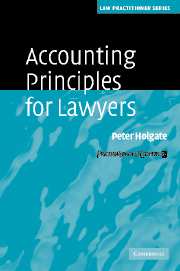Book contents
- Frontmatter
- Contents
- Acknowledgements
- Glossary of terms
- Part I The accounting environment
- Part II Some specifics
- 8 Individual entity accounts and consolidated accounts
- 9 Mergers and acquisitions
- 10 Interaction of accounting with tax
- 11 Assets
- 12 Liabilities
- 13 Leases
- 14 Pensions
- 15 Financial instruments, including capital instruments
- 16 Realised and distributable profits
- 17 Disclosures in published accounts
- 18 Use of financial information in contracts and agreements
- Appendices
- Index
16 - Realised and distributable profits
from Part II - Some specifics
Published online by Cambridge University Press: 28 July 2009
- Frontmatter
- Contents
- Acknowledgements
- Glossary of terms
- Part I The accounting environment
- Part II Some specifics
- 8 Individual entity accounts and consolidated accounts
- 9 Mergers and acquisitions
- 10 Interaction of accounting with tax
- 11 Assets
- 12 Liabilities
- 13 Leases
- 14 Pensions
- 15 Financial instruments, including capital instruments
- 16 Realised and distributable profits
- 17 Disclosures in published accounts
- 18 Use of financial information in contracts and agreements
- Appendices
- Index
Summary
Introduction
The questions of which profits are realised and which are distributable are important for both accountants and lawyers. The questions arise for an individual company, not for a group: it is companies that make distributions, not groups. Thus, for example, in a simple group comprising a parent and its subsidiary, the subsidiary may make a distribution to its parent out of profits available for that purpose. The parent may then, if it has profits available for distribution, make a distribution to its shareholders. But to speak of the group having distributable profits or having made a distribution is not valid.
Accordingly, the matters discussed in this chapter relate to individual companies; and, as the focus is on UK law, the discussion concerns what amounts are realised and distributable for UK companies. For companies registered in other countries, the rules may be different from those in the UK, though the rules for companies registered in other EU Member States are likely to be broadly similar, as the national laws of all Member States are based on the second EU company law directive of 1976.
‘Realised’ and ‘distributable’
The two terms ‘realised’ and ‘distributable’ are related but separate and it is important to distinguish them.
It is appropriate to speak of a specific component of profit or gain as being realised (or not). Taking a very simple example, if a company buys an asset for 100 and sells it for cash of 120, it has made a realised profit of 20.
- Type
- Chapter
- Information
- Accounting Principles for Lawyers , pp. 160 - 173Publisher: Cambridge University PressPrint publication year: 2006



